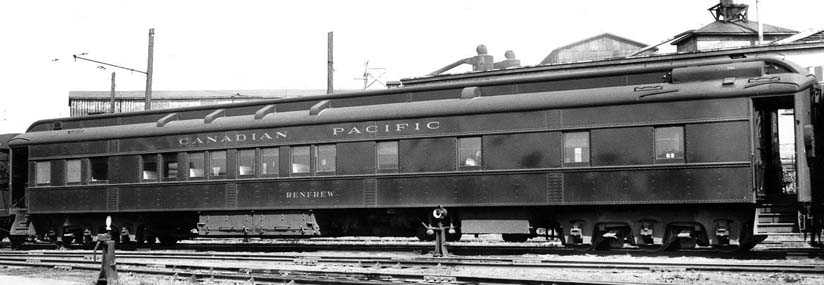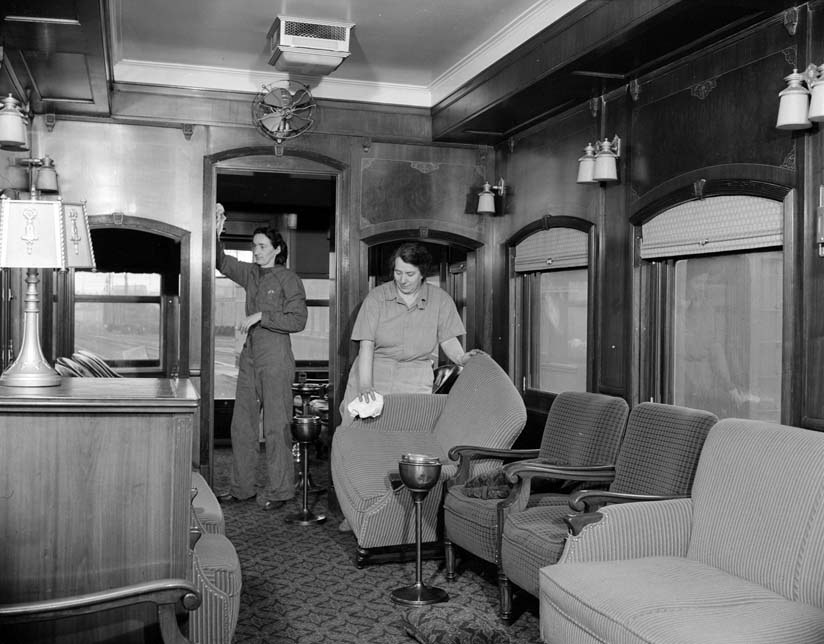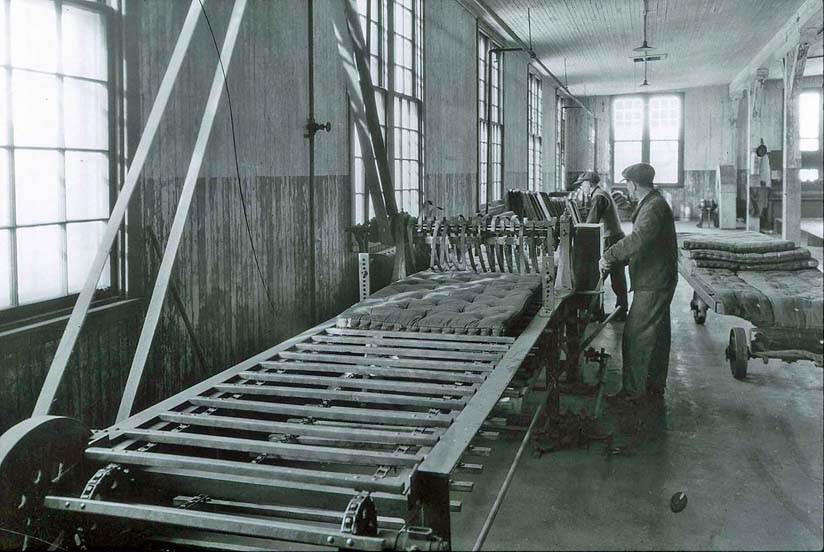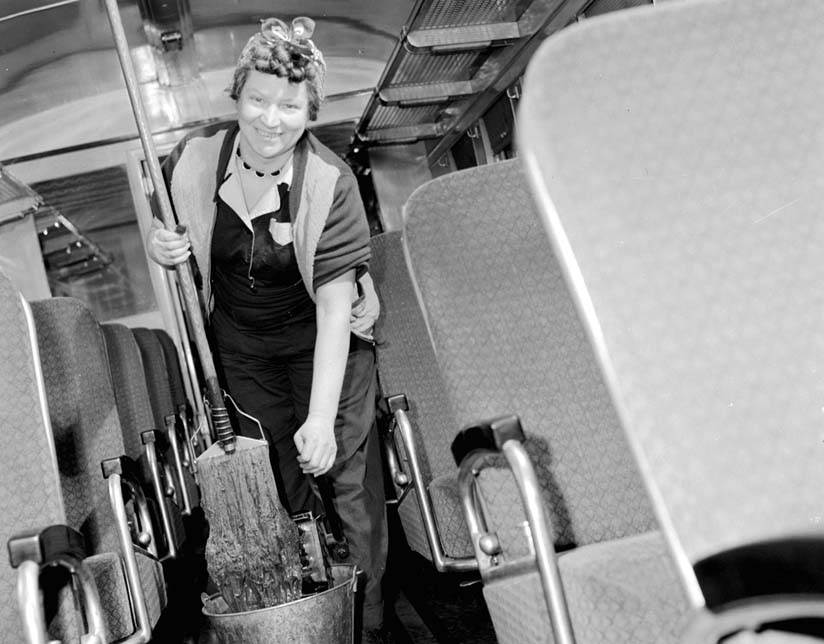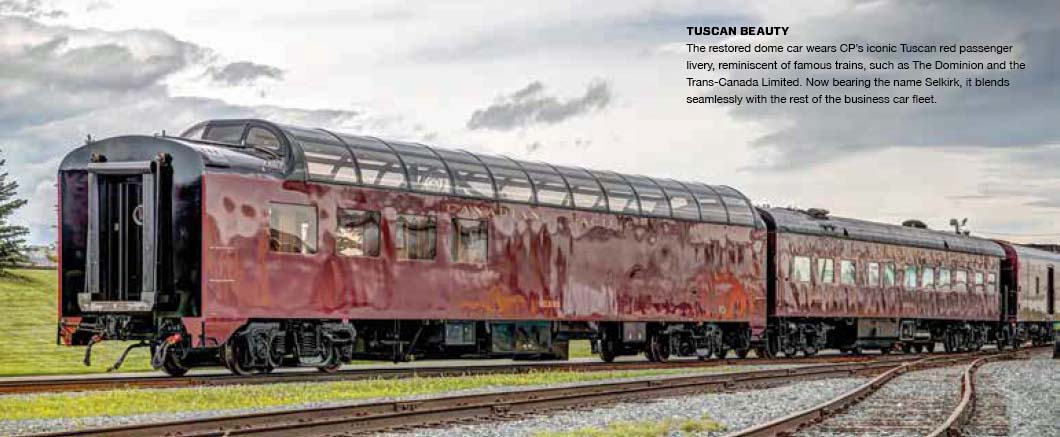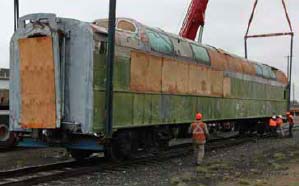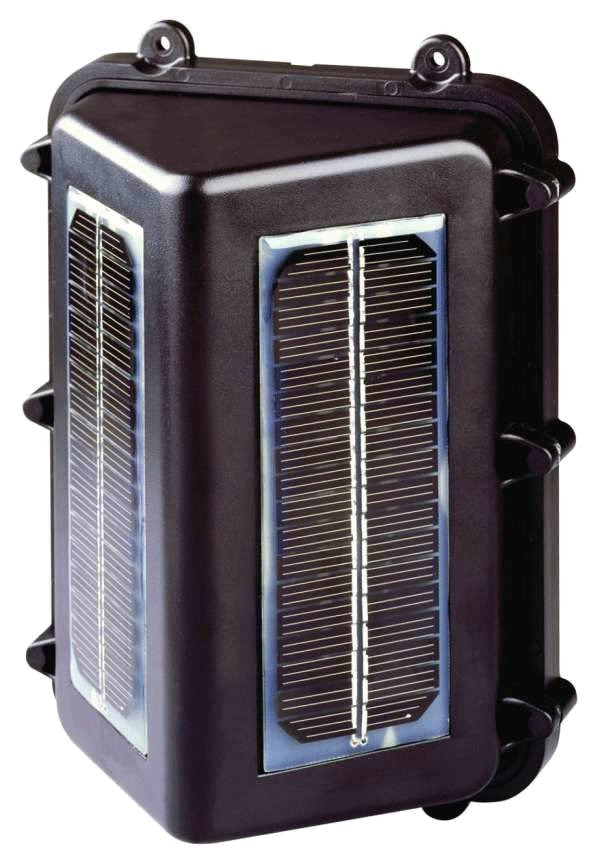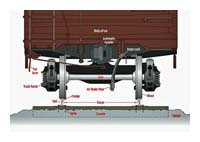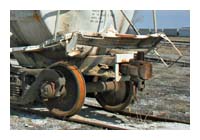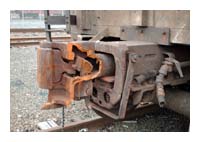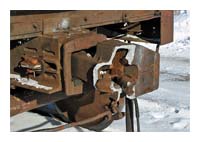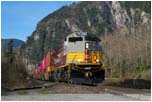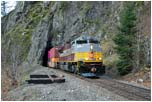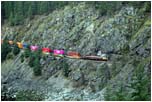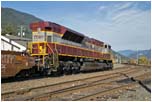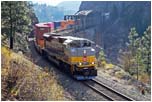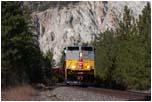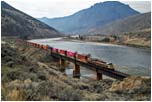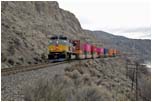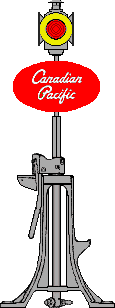 | Canadian Pacific Odds and Ends - Part 12 Articles |
| Ninety Years of Service - Bill Linley Sleeping Car Laundries - Montreal Gazette Just Another Rail Tail - Anonymous Author Selkirk Sunrise - Canadian Pacific DC Traction Motor Flashover - Andy Cassidy New Life for Old Locomotives - Canadian Pacific Locomotive Monitoring Unit - Andy Cassidy SD70ACu Number 7010 - Ken Storey OKthePK's website "Last Call" page has appeared weekly over the past few years. Each week a different article told the story of various railway items of interest. While some of the articles were saved they are no longer available online. Many of those about the Canadian Pacific Railway have been compiled here on this page. There is insufficient room to display more than a few Last Call articles per page. As a result, "Canadian Pacific Odds and Ends - Part 12", continues this month with more possible parts to follow as time passes.  Ninety Years of Service By Bill Linley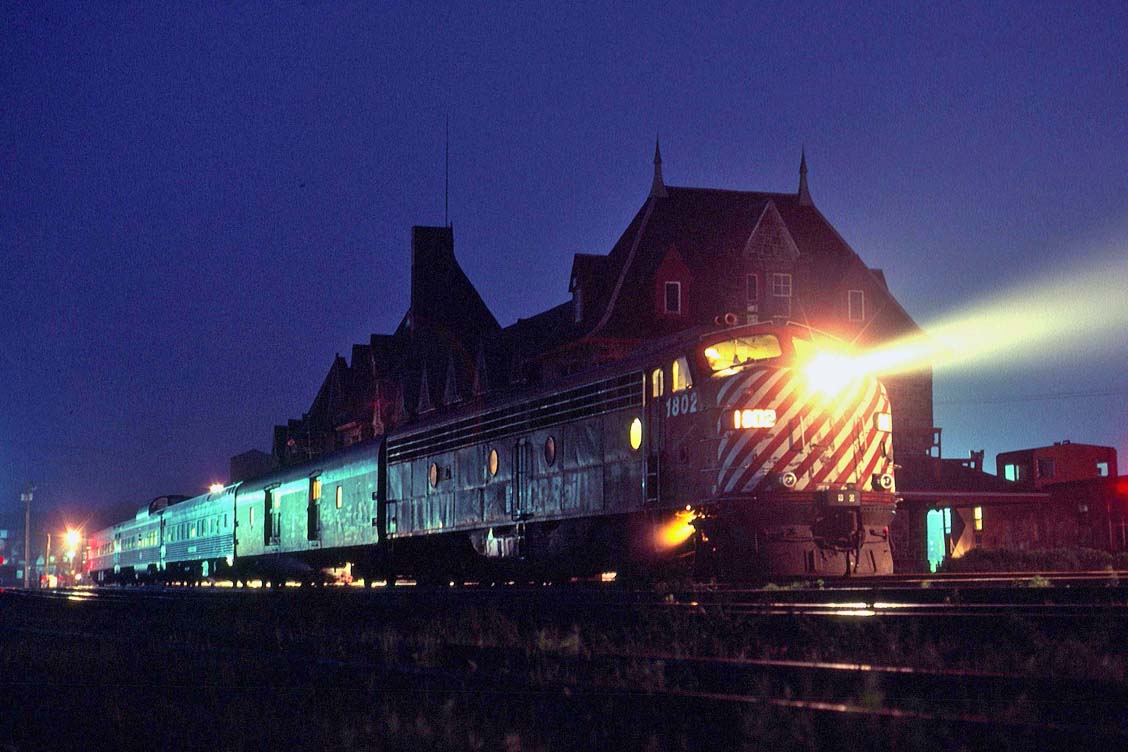 CP Rail number 1802 heads Train 41, the Atlantic Limited, at McAdam, New Brunswick - 3 Jun 1979 Bill Linley. The westbound Saint John to Montreal train had covered the 84.4 miles of the McAdam Subdivision and will depart at 22:10. It will follow Canadian Pacific Railway's (CP) "Short Line" through northern Maine that had opened to passenger service exactly ninety years before. The opening of the Short Line made CP a line from sea to sea across North America. It was not so until December 1974 when CP Rail purchased the Maine Central line from Mattawamkeag, 56.1 miles to Vanceboro, Maine. Previously, they had enjoyed trackage rights. 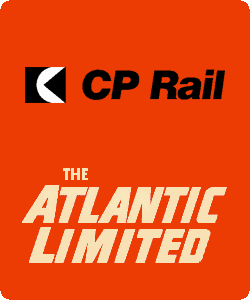 The makeup of this train was the same as it had been for most of the 1970s. The four cars included baggage number 2767, the 4-5-1-4 sleeper Grant Manor, Skyline dome number 505, and coach 123. On this particular trip, Grant Manor replaced Draper Manor, which regularly ran with 505 and 123. Reportedly, senior conductor George Draper, out of Montreal, often arranged its reinstatement when "his car" was not in the consist. On the opposite set of equipment was Cameron Manor, long associated with baggageman Dave Cameron. This sleeper usually ran eastbound on the rear behind Skyline 515 and coach 119. The two dome cars were specially fitted with walkover seats in the dome section so that passengers would not have to ride backwards. Crews switched, not turned, the cars, so that the sleeper ran backwards behind the baggage car on the westbound trip with the coach on the rear. As CP became disenchanted with passenger service in the 1960s, it is remarkable that they did not discontinue this train, nor replace it with an RDC. Despite often very low revenue passenger counts, it continued as a full-featured daily train until VIA upgraded it and extended it to Halifax, Nova Scotia, on Sunday, 28 Oct 1979 as their "Atlantic". Behind the train, W.H. Painter's Chateau style station-hotel of 1901 dominates the scene. The station supported the intense traffic generated at the junction of CP lines to St. Andrews and St. Stephen to the south, and Edmundston to the north. It featured a 20 room hotel on the second floor, station services on the ground floor, including a restaurant and coffee shop hidden behind the locomotive. The Canadian government designated the station as a National Historic Site in 1976 and a Heritage Railway Station in 1990. 
Sleeping Car Laundries Toronto Mail and EmpireThis "R" series sleeping car named "Renfrew" was built for the Canadian Pacific Railway. The car was retired in 1971 until purchased in 1973 for use as a restaurant in Surrey, British Columbia - 19 Jul 1947 Dave Shaw - Railway Memories. One of the necessities of modern railway management is to keep the cars, particularly the sleeping cars and their furnishings, in clean and sanitary condition. We learn from the Canadian Pacific Staff Bulletin that car cleaning is a special business. The company's largest staff for this kind of work is maintained at the Glen Yards, Montreal. Housewives could get many tips from watching the special cleaning given sleeping cars every nine or ten days. About ten special cleaning jobs are done at the Glen Yards every day, an equal number at Vancouver, and more at Toronto and other points across the country. Live steam, compressed air, and vacuum cleaners do much of the work, but even with the assistance of these and other labour saving devices it takes 25 man hours for the complete cleaning, inside and out, of a sleeping car. In the first place everything is taken from the car, carpets, seat cushions, mattresses, drapes, bedding, headrests, pillows, blankets, and berth curtains. When the car looks as if it were about ready for scrapping. the cleaning begins. Cleaning the interior of a solarium lounge car - 17 Mar 1943 Photographer? - Don Coltman Photos - City of Vancouver Archives AM1545-S3-: CVA 586-1169. The furnishings that have been taken from the cars are put through several novel processes which thoroughly clean them. The linen, of course, is not handled by the car cleaners. This important department is left to the sleeping and dining car officials who have an elaborate system of checking. Blankets and berth curtains, air-cleaned every time a car is cleaned at Montreal, or any other terminal, are sent periodically for dry-cleaning. The blankets, are especially made for the company, and are too valuable to be trusted to the ordinary wash-tub. The air-cleaning machine is a simple device, a pipe with many vents, which forces air under 70 pounds pressure through the blankets, removing all dust. Also taken to the same dust mill are the seats and carpets. Compressed air, applied to the seats by an easily operated hand machine, blows clouds of dust from the interior of the seat, the top and along the edges. This cleaning is done with a thoroughness and rapidity that is truly amazing to the layman. Cleaning a Canadian Pacific Railway coach - 1943 Photographer? - Don Coltman Photos - City of Vancouver Archives AM1545-S3-: CVA 586-1166. The process used in cleaning carpets would be a revelation to husbands who spend sweaty hours in the backyard, beating an unfortunate carpet slung over a clothes line. The carpet, nap down, is run through a large machine. About fifty leather paddles, a foot long and about two inches wide, revolve on a main axis to beat out all the dust. Compressed air is used to carry the dust away to another part of the building, and revolving brushes keep the nap of the carpet looking neat and new. A machine for cleaning mattresses possibly located at Glen Yard in Montreal. One can imagine the dust produced while the workers wear no protective masks - Date? Photographer? - Public Archives of Canada. Mattresses and pillows arc also placed on a moving table and subjected to the same kind of beating and air cleaning. Besides dislodging all the dust, the air carries it to another part of the building. The work here is done quickly and efficiently, as in all other processes employed in cleaning the cars. Mopping the floor of a Canadian Pacific Railway coach - 1943 Photographer? - Don Coltman Photos - City of Vancouver Archives AM1545-S3-: CVA 586-1168. In addition to the furniture and other cleaning at the Glen Yards, a typical list extends to such items as 165 sheets, 140 pillow cases, 200 face towels, 54 blankets from the beds, and 13 "storm" blankets, those that are hung to check window drafts. What a washing for any Monday morning! See the article Passenger Car Cleaning by George Whiteley Superintendent of Motive Power and Car Department.  Just Another Rail Tail Anonymous Author Extra 9000 West at Tranguille - 21 Feb 1996 John Leeming. Wish I had a camera with us the day the Brakeman and I stopped the Westbound Coal Train at the entrance to the Haig tunnels west of Choate siding, to check out a report of an injured fawn laying near the rails inside the tunnel. It was about 04:00, raining like crazy, and we were on the first brand new 9000 Locomotive which CP had in coal service. We thought it was really something, with desk top controls etc., of course over time many came to dislike the first editions of the 9000's. The newer versions improved dramatically. The brakeman and I got off the engine and walked into the tunnel to find a little fawn, soaking wet and shivering, laying in puddle of muddy water with a cut on the top of it's head. It must have thought it was being abducted by aliens, as it was staring at us standing over it with the glare of the lights of this huge locomotive in the background. We decided to pick up the fawn and take it to the Locomotive then got on the phone to let our Conductor know what was going on. We figured the mother deer probably wouldn't be back for the little fawn so we proceeded west with the it onboard. The brakemen got out the first aid kit and cleaned up the gash on top of the fawn's head then wrapped the little guy in a bunch of dry rags, turned the cab heater on high to warm it up, opened up a bottle of water and it sucked water out of the bottle. Now there was a camera moment, and NO camera. If you recall back then CP had an amateur photo contest that employees could enter and win prizes if good enough. The brakeman thought we might win hands down with us holding the little deer at the engineer's controls with the engine number 9000 featured in the background with the caption, "Even the deer on the Cascade Sub like the new 9000's", a missed opportunity for sure. 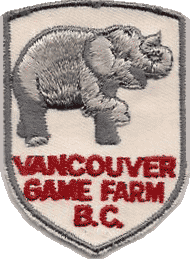 We called the dispatcher in Calgary, who couldn't believe we had a deer on board, but after explaining what had happened, he was quite amused by the whole thing. The dispatcher contacted the Vancouver Game Farm in Aldergrove, who sent a truck out to the wye at Mission where the brakeman handed the fawn to the game farm truck waiting for us. It was a good feeling to have been able to help that little fawn, because as you know, there are so many animals killed or injured by trains, so this was a win-win. The little guy did survive. We received notice that CP received a note from the Vancouver Game Farm that the deer was doing well and invited the train crew to the Game Farm for a visit. I believe the brakeman took his daughter to see the little fawn, who was not so little any more.  VOL. 24 | 2019 Selkirk Sunrise A Unique dome car is added to CP's heritage car fleetCanadian Pacific Railway dome-observation car named "Selkirk" - Date? Photographer? - CP.  EDITORSVanessa DiFruscia, Mallory McCredieWRITERS & CONTRIBUTORSJeremy Berry, Christine Brown, Ariella Calin, Andy Cummings, Vanessa DiFruscia, Brenda Land, Mallory McCredie, Adam Meeks, Melissa Murray, Leah Ryan, Salem WoodrowDESIGNGeminesse JohnsonILLUSTRATION & PHOTOGRAPHYJon Evans, Kris Grunert, Danny Schlitz, Sean Stewart, Amanda Tessmann, Fritz Tolentino, John Woods, Neil Zeller Finding the right car was only the beginning. Years of neglect by previous owners had resulted in it being unable to move on its own wheels, so it was partially disassembled and loaded onto a flatcar for the trip to Calgary, where it would be restored. Once at the old Ogden locomotive shop, its journey back to life began. During a period of nine months, the Heritage Operations team painstakingly dismantled the dome car down to its frame and rebuilt it from the ground up. The scope of work included refurbishing or replacing all the mechanical components, adding new structural members, equipping the car with modern plumbing and electrical systems, and installing a breathtaking custom designed interior. Completing a project of this magnitude on such a short time line presented a tremendous number of obstacles, but the team rose to the challenge with outstanding results. On Thursday, 13 June 2019, CP welcomed a dome car back onto its roster for the first time in nearly 40 years, as the Selkirk made its maiden voyage westward out of Calgary. After a successful multi-day trip through the Rockies, consensus among passengers was that the Selkirk must now be one of the most beautiful rail cars in the world.  DC Traction Motor Flashover Attached are three photos of the armature end of a few traction motors to illustrate to those who are not sure what is talked about here. Not the greatest examples, but you will get the idea. The first shot (below) is of a traction motor armature that is damaged from a "flashover" or arcing. 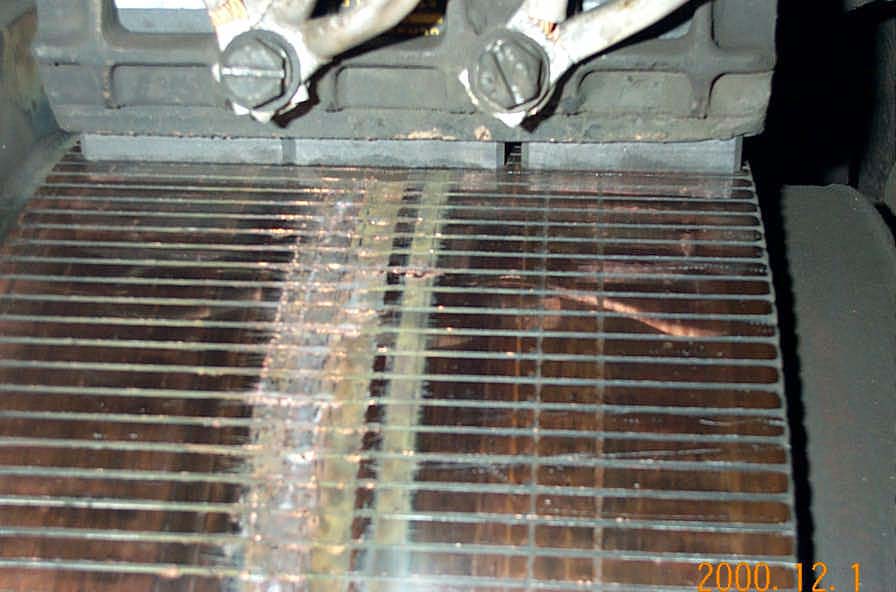 A DC traction motor commutator with flashover damage - 1 Dec 2000 Andy Cassidy. This second photo is of an armature in good running condition 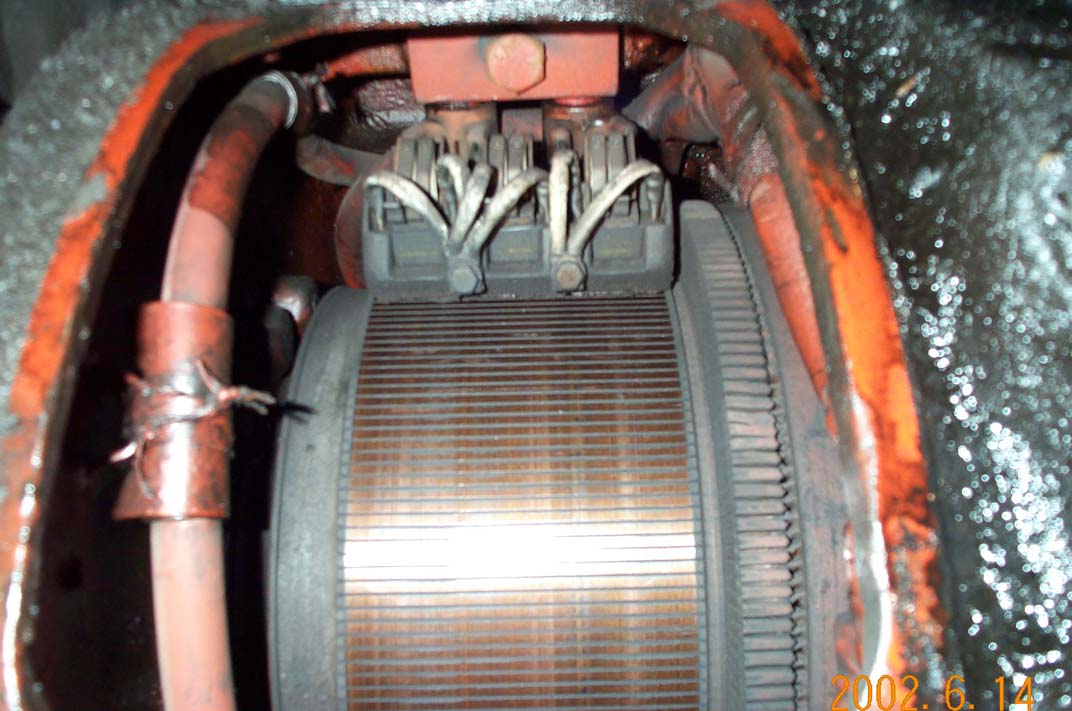 A DC traction motor commutator in acceptable condition - 14 Jun 2002 Andy Cassidy. This last photo, is of a rebuilt motor sitting on the shop floor, all nice and clean inside. 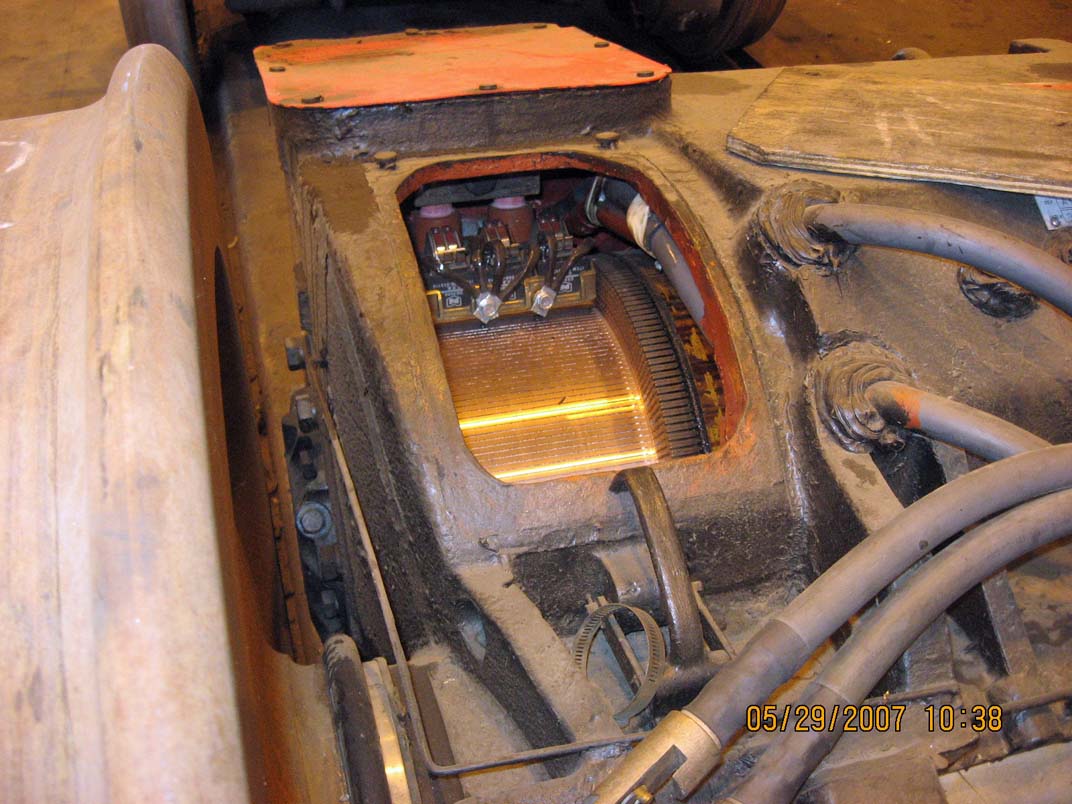 A rebuilt DC traction motor - 29 May 2007 Andy Cassidy. The motors are suspended on the axles of the locomotive. 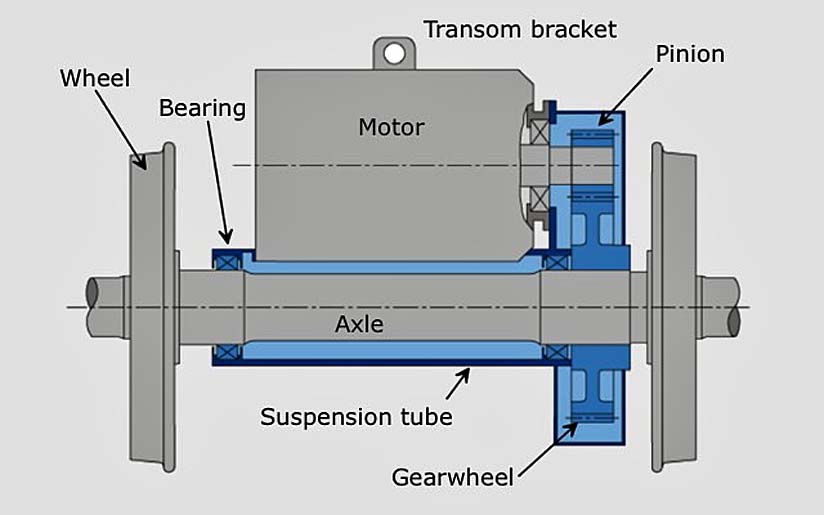 Drawing of a nose suspended traction motor. The motor drives the axle through a pinion/gear wheel set, with the gear wheel pressed onto the axle. The motor weight is distributed between the transom of the bogie and the axle. The axle carries the weight of the motor through a suspension tube. So when a unit running at high speed under power hits a rough portion of track, the bouncing can cause the brushes to lift slightly and result in sparking which burns the commutator as seen in the first shot. If the flash is big enough it can extend to the frame of the motor and cause a "ground fault". Unlike your car, the electrical system is not grounded, but the body of the locomotive is connected to the electrical system through a "ground relay" that monitors for any electrical connection from the locomotive power system to the body of the unit. This would happen if wire insulation broke down, or was cut by some clamp, or whatever, for example, and also a flash in the traction motors or main generator that has a similar but larger, commutator. A ground fault will activate the ground relay and cause the unit to stop loading. On most DC road units the ground relay is reset automatically but counted until a predetermined number of ground fault trips are recorded whereby it locks out and has to be reset manually. Obviously investigation and repairs are required by that time. Once the commutator gets damaged, as in the first photo, it just grinds the carbon brushes down like sandpaper, so the motor has to be changed out and properly repaired. 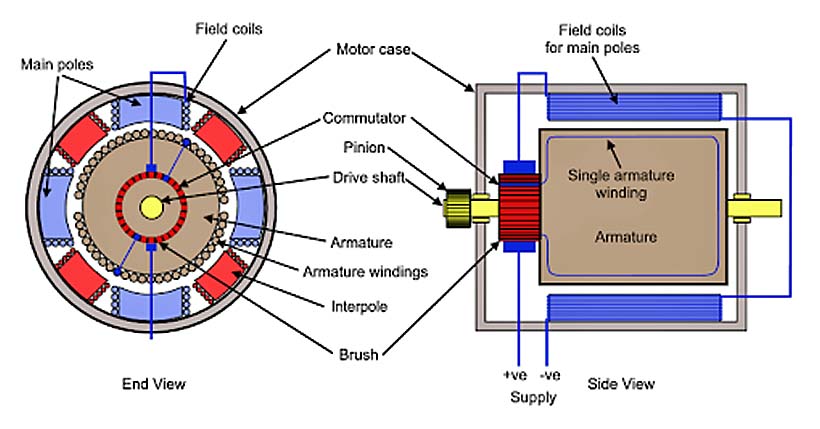 Schematic of the basic structure of a series wound DC traction motor showing the main parts and how the rotor (the armature) sits inside the field coils (the stator). The two parts are joined electrically through the commutator. The commutator rotates with the armature and provides the connection to the field coils through the brushes. An AC unit on the other hand, has no commutator in the traction motors, or main alternator, so is not affected by this commutator issue. They still get ground faults, but not from flashovers as discussed above.  New Life for Old Locomotives 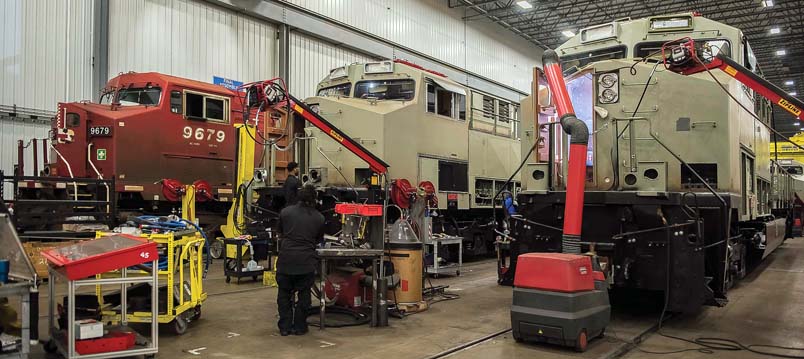 Locomotive re-building underway - Date? Photographer? - CP. As part of a multi-year plan to modernize CP's aging fleet, 30 high-horsepower, six-axle AC locomotives will run through the modernization program in 2017, with more slated for 2018. "We worked closely with GE to develop a model specifically tailored to meet CP's needs," said Tom Lambrecht, Assistant Vice-President Mechanical Locomotive. "Over the years, we've identified reliability issues with aging equipment and are investing in technology that will eliminate those failures in the future, allowing better overall fleet reliability and supporting CP's ongoing mandate to improve service quality while reducing operating costs." Piece by piece, each locomotive is taken apart and rebuilt. From a new main and auxiliary cab to a new diesel engine and cooling system, the modernized fleet will have all the capabilities of a new locomotive but with a lesser price tag. "Our partners are always looking for more capital efficient ways to do things," said John Manison, General Manager Locomotive Modifications for GE. "So we really shifted focus in early 2016 and built a whole organization around modernizations and capital efficient answers to help our customers, like CP, become more efficient." Building a strong collaborative relationship over the past 20 years, CP and GE identified the areas of opportunity where modernizing technology would be an economically viable way to improve performance. GE's Jim Hilderhoff, responsible for commercial sales for the Americas, has been a part of the CP relationship from the day the first AC4400 locomotives were purchased. Jim is particularly proud of the relationship both companies have cultivated over the years. "It's been a journey for both of us, one I'm grateful to be a part of," said Jim Hilderhoff. "We've been able to stay close and work together through challenges, as business demands changed over time. The modernization program is just another great example of creating a platform to extend this partnership that is working well for both companies and therefore working for our shareholders and respective customers." Canadian Pacific Magazine followed our AC 4400 locomotives to GE's locomotive manufacturing plant in Fort Worth, Texas, to see how 200 tons of steel gets stripped down and rebuilt into a modern powerhouse.  Locomotive Monitoring Unit (LMU) By Andy Cassidy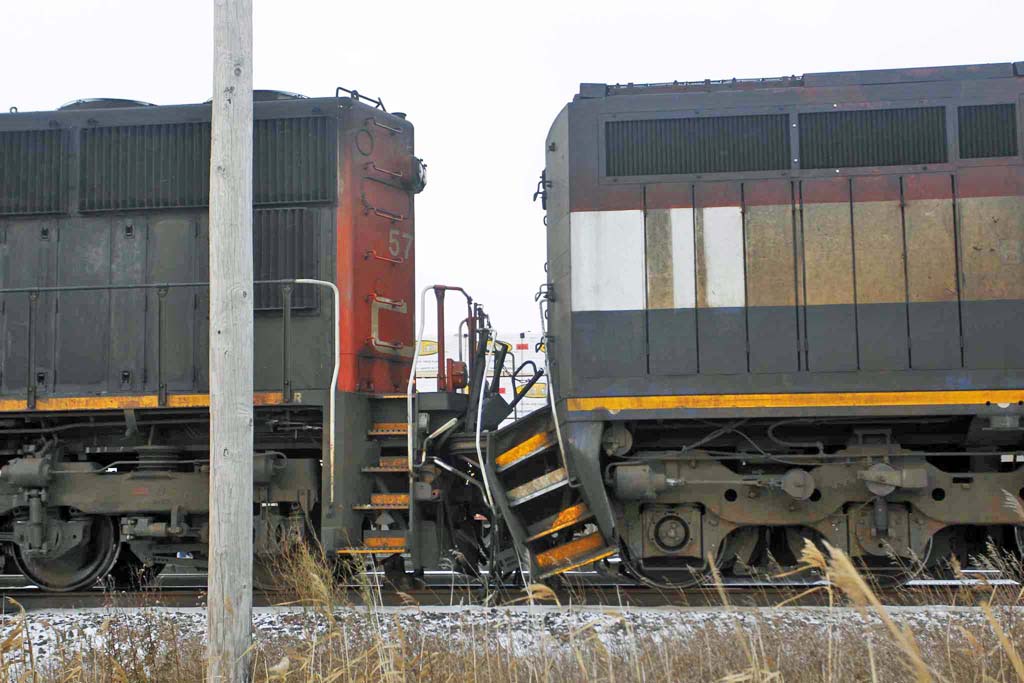 Impact damage between two Canadian National locomotives - Date? Photographer? Several Canadian Pacific GP7 and GP9 locomotives have gone to the scrappers torch at ABC metals in Surrey in the last few years. In this case CP 1530, a GMD GP9u, was one of those heading over to Southern Railway (SRY) for the move. As you can see there's an odd looking device on the rear hood of the unit. 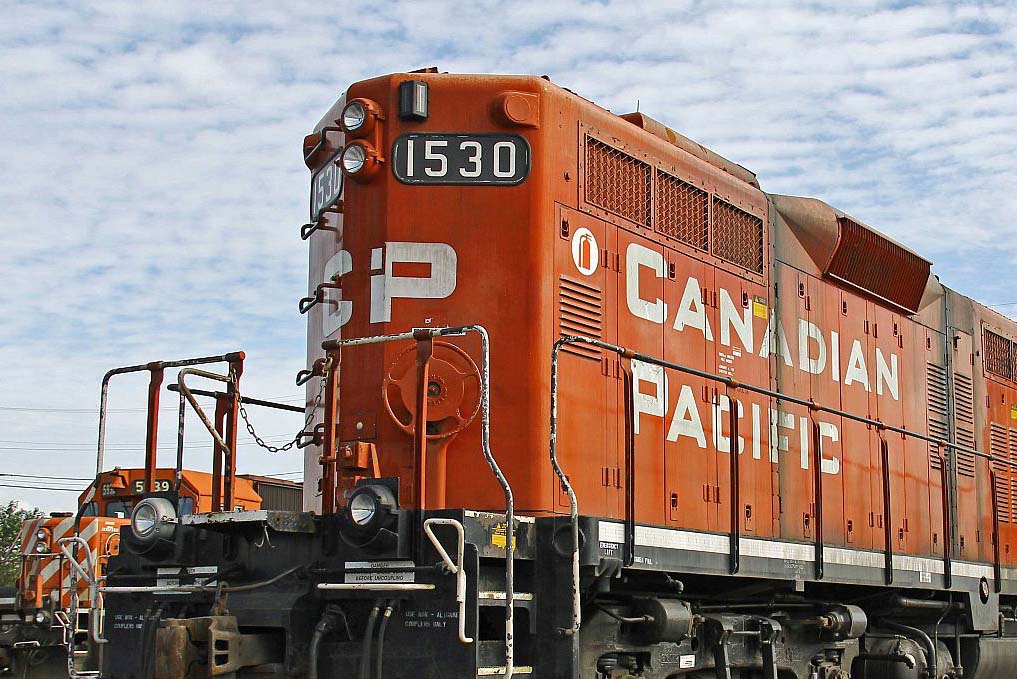 CP 1530 - 29 Sep 2012 Andy Cassidy. This would be a Lat-Lon company Locomotive Monitoring Unit (LMU), applied to monitor for heavy impacts as in the example of the two CN units above. When a heavy impact is detected, the LMU automatically notifies Lat-Lon and they send out a message to various management personnel. This allows a timely investigation to determine what the problem was. It wasn't the intent of the LMU's to get the operator or crew in trouble but there was so much damage from heavy impacts on locomotives, yard switchers in particular, mainly run by beltpack, that something had to be done. 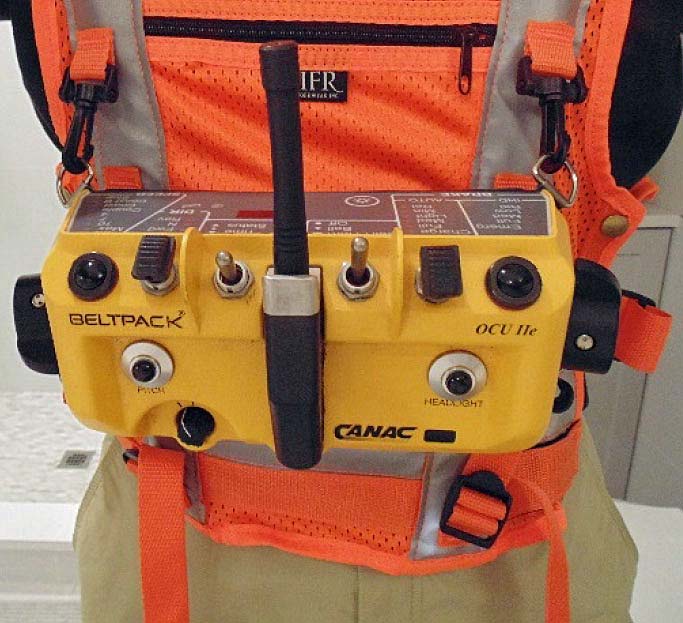 A Beltpack remote locomotive control device - Date? Photographer? So yes, some crews did get themselves in hot water, but overall the units had to be saved from almost continuous damage. Although not part of the Vancouver fleet this particular unit wasn't equipped with Beltpack remote control and the LMU had been applied by the Winnipeg shop.  SD70ACu Number 7010 Ken Storey |
